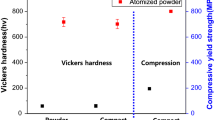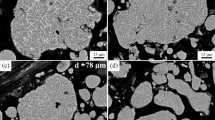This work allowed the study and comparison of the cooling rate, surface morphology, and microstructure of nickel-based super-alloy powders produced by the atomization of argon and nitrogen. The results show that the principal phase in argon and nitrogen atomized powders has an FCC structured γ-phase with γ′-strengthening phase. X-ray diffraction detected no apparent nitride or oxide on the powder surface. The interplanar spacing and lattice constant of γ-phase increase as the powder size decreases. Nitrogen- and argon-atomized powders are spherical, but argon- atomized powders have higher sphericity and smoother surfaces. Atomization by argon has produced a small number of satellite particles, whereas atomized nitrogen powders have more split particles. The proportion of special-shaped powder decreases with the decreasing powder particle size. The super-alloy powder with high sphericity can be effectively obtained by controlling the particle size. Because of the higher coefficient of thermal expansion, the trough of argon-atomized powders is higher than that of nitrogen-atomized powders with the same particle size. As the powder particle size decreases, the hollowness of the powders declines for both powders, with the argon- atomized powder falling more quickly. The cooling rate of melted alloy droplets has an essential effect on the surface characteristics of the powder. The dendrite morphology of argon-atomized powders is more evident than that of nitrogen-atomized powders. As the powder particle size decreases, the radial dendrites gradually disappear, with dendrites and cellular crystals dominating the powder surface. The cooling rate of the powder is calculated based on the surface secondary dendrite arm spacing. It is found that argon-atomized powders exhibit cooling rates from 2.09 × 104 K ∙ s–1 to 1.26 ∙ 105 K ∙ s–1, while nitrogen-atomized powders show higher cooling rates in the range between 2.71 ∙ 104 K ∙ s–1 and 1.86 ∙ 105 K · s–1. Because of the higher cooling rate, nitrogen- atomized powders have a lower secondary dendrite arm spacing than argon-atomized powders with similar particle sizes.







Similar content being viewed by others
References
X. Chen, X.Y. Wang, Q. Liu, Z.M. Yang, X.W. Bo, and Y.H. Wang, “Development status of the preparation of nickel-based superalloy spherical powder,” Powder Metallurgy Industry, 32, No. 2, 96–100 (2022).
Y.J. Liu, Q. Hu, X.M. Zhao, Z.G. Wang, S.M. Zhang, Y.H. Wang, and J.H. Zhang, “Investigation of centrifugal atomization technology of high fluidity aluminium alloy powder for additive manufacturing,” Rare Metal Materials and Engineering, 50, No. 5, 1767–1774 (2021).
D. Tourret, C.A. Gandin, T. Volkmann, and D. Herlach, “Multiple non-equilibrium phase transformations: Modeling versus electro-magnetic levitation experiment,” Acta Materialia, 59, No. 11, 4665–4677 (2011).
Y. Chen, J.Y. Zhang, B. Wang, and C.G. Yao, “Comparative study of IN600 superalloy produced by two powder metallurgy technologies: argon atomizing and plasma rotating electrode process,” Vacuum, 156, 302–309 (2018).
S.W. He, Y. Liu, and S. Guo, “Cooling rate calculation of non-equilibrium aluminum alloy powders prepared by gas atomization,” Rare Metal Materials and Engineering, 38 (S1), 353–356 (2009).
N. Zeoli and S. Gu, “Computational validation of an isentropic plug nozzle design for gas atomization,” Computational Materials Science, 42, No. 2, 245–258 (2008).
Jie L.C., Peng C.Q., Wang R.C., Z.Y. Cai, W.S. Liu, and R.L. Ma, “Influences of cooling rate on microstructures and morphologies of non-equilibrium Al–27% Si alloy powders by gas atomization,” Rare Metal Materials and Engineering, 44, No. 4, 1006–1011 (2015).
H.Y. Pan, Y. Liu, and S.T. Song, “Study on the ceramic nozzle used for preparing superalloy powder in argon atomization,” Central Iron and Steel Research Institute Technical Bulletin, 6, No. 1, 59–63 (1986).
M.X. Zhang, C.J. Wang, Q.M. Chen, J.Q. Hu, and J.X. Liang, “Effects of processing parameters of gas atomization on characteristics of PH13-8Mo steel powders,” Heat Treatment of Metals, 44, No. 12, 112–115 (2019).
P.X. Zhu, S.M. Zhang, J. Xu, X.X. Zhu, and X.M. Zhao, “Effects of processing parameters of gas atomization on particle size of 316L stainless steel powders,” Materials Science and Engineering of Powder Metallurgy, 15, No. 4, 388–393 (2010).
M. Xia, P. Wang, X.H. Zhang, and C.C. Ge, “Computational fluid dynamic investigation of the primary and secondary atomization of the free-fall atomizer in electrode induction melting gas atomization process,” Acta Physica Sinica, 67, Issue 17 (2018), DOI:https://doi.org/10.7498/aps.67.20180584.
C.F. Gao, Z.Y. Xiao, H.P. Zou, Z.Q. Liu, J. Chen, S.K. Li, and D.T. Zhang, “Characterization of spherical AlSi10Mg powder produced by double-nozzle gas atomization using different parameters,” Transactions of Nonferrous Metals Society of China, 29, 374–384 (2019).
L.M. Sang, Y. Xu, P.J. Fang, H.L. Zhang, Y.T. Cai, and X.Y. Liu, “The influence of cooling rate on the microstructure and phase fraction of gas atomized NiAl3 alloy powders during rapid solidification,” Vacuum, 157, 354–360 (2018).
Y. Ma, J.F. Bao, Y. Hu, H. Wang, and D.D. Hu, “The impact of vaccum atomization parameters on the particle size distribution and morphology,” Thermal Spray Technology, 6, No. 1, 45–48 (2014).
Z. Li, Z.H. Zhang, G.Q. Zhang, G.F. Mi, Z.W. Liu, S.F. Tian, and M.N. Yan, “Study of atomization gas velocity,” Powder Metallurgy Technology, 17, No. 1, 10–13 (1999).
Z.J. Gao, G.Q. Zhang, Z. Li, H. Yuan, W.Y. Xu, Y. Zhang, and N. Liu, “Microstructure characteristics of superalloy powders during rapid solidification prepared by argon atomization,” Powder Metallurgy Technology, 29, No. 2, 93–97 (2011).
P.J. Fang, Y. Xu, X.G. Li, and Y. Chen, “Influence of atomizing gas and cooling rate on solidification characterization of nickel-based superalloy powders,” Rare Metal Materials and Engineering, 47, No. 2, 423–430 (2018).
B.Z. Nong, Y.Z. Zhang, Z.M. Liu, B. Wei, and B. Cao, “Microstructure and properties of new nickel-based superalloy powder prepared by argon atomization,” Materials Science and Engineering of Powder Metallurgy, 26, No. 6, 547–553 (2021).
Y. Zhou, Materials Analysis Methods, China Machine Press, Beijing (2004).
L.L. Lu, S.M. Zhang, J. Xu, Y.W. Sheng, S.S. Wang, W.D. Zhao, J.H. Zhang, and X.M. Zhao, “Solidification characterization of K418 alloy powders fabricated by argon gas atomization,” Materials Science Forum, 849, 788–793 (2016), DOI:https://doi.org/10.4028/www.scientific.net/MSF.849.788.
M.Y. Zheng, S.M. Zhang, Q. Hu, H.J. He, Y.W. Sheng, and X.M. Zhao, “Microstructural characterisation of CuAgZr powder particles produced by argon gas atomization,” Powder Metallurgy, 61, No. 3, 231–240 (2018).
Y.B. Wang, L.M. Peng, Y.Z. Ji, X.X. Cheng, N. Wang, Y. Zhao, Y.A. Fu, L.Q. Chen, and W.J. Ding, “The effect of low cooling rates on dendrite morphology during directional solidification in Mg–Gd alloys: In situ X-ray radiographic observation,” Materials Letters, 163, 218–221 (2016).
G.H. Gessinger and M.J. Bomford, “Powder metallurgy of superalloys,” Metallurgical Reviews, 19, Issue 1, 51–76 (1974), https://doi.org/10.1179/imtlr.1974.19.1.51.
E.J. Lavernia, J.D. Ayers, and T.S. Srivatsan, “Rapid solidification processing with specific application to aluminium alloys,” International Materials Reviews, 37, Issue 1, 1–44 (2013), https://ideaexchange.uakron.edu/mechanical_ideas/585.
T.R. Anantharaman and C. Suryanarayana, “Review: A decade of quenching from the melt,” Journal of Materials Science, 6, No. 8, 1111–1135 (1971).
P. Peng, X.Z. Li, J.G. Li, Y.Q. Su, J.J. Guo, and H.Z. Fu, “Detachment of secondary dendrite arm in a directionally solidified Sn–Ni peritectic alloy under deceleration growth condition,” Scientific Reports, 6, Article No. 27682 (2016).
P.A. Joly and R. Mehrabian, “Complex alloy powders produced by different atomization techniques: relationship between heat flow and structure,” Journal of Materials Science, 9, 1446–1455 (1974), https://doi.org/10.1007/BF00552930.
S.S. Chen, K.L. Zeng, X.Q. Song, and J. Zhu, “Vacuum gas atomized metal powder “satellite” forming mechanism,” Materials Research and Application, 13, No. 1, 44–47 (2019).
J. Hu, Y.B. Li, H.L. Wang, and W.C. Ren, “Improvement of the corrosion resistance of Cr–N coated aluminum matrix composite by magnetron sputter,” Materials Letters, 62, No. 10, 1715–1717 (2008).
Author information
Authors and Affiliations
Corresponding author
Additional information
Published in Poroshkova Metallurgiya, Vol. 61, Nos. 11–12 (548), pp. 3–15, 2022.
Rights and permissions
Springer Nature or its licensor (e.g. a society or other partner) holds exclusive rights to this article under a publishing agreement with the author(s) or other rightsholder(s); author self-archiving of the accepted manuscript version of this article is solely governed by the terms of such publishing agreement and applicable law.
About this article
Cite this article
Zhong, W., Peng, H., Jiao, D. et al. Comparative Study of Nickel-Based Super-Alloy Powders Atomized by Argon and Nitrogen. Powder Metall Met Ceram 61, 633–643 (2023). https://doi.org/10.1007/s11106-023-00352-x
Received:
Published:
Issue Date:
DOI: https://doi.org/10.1007/s11106-023-00352-x




